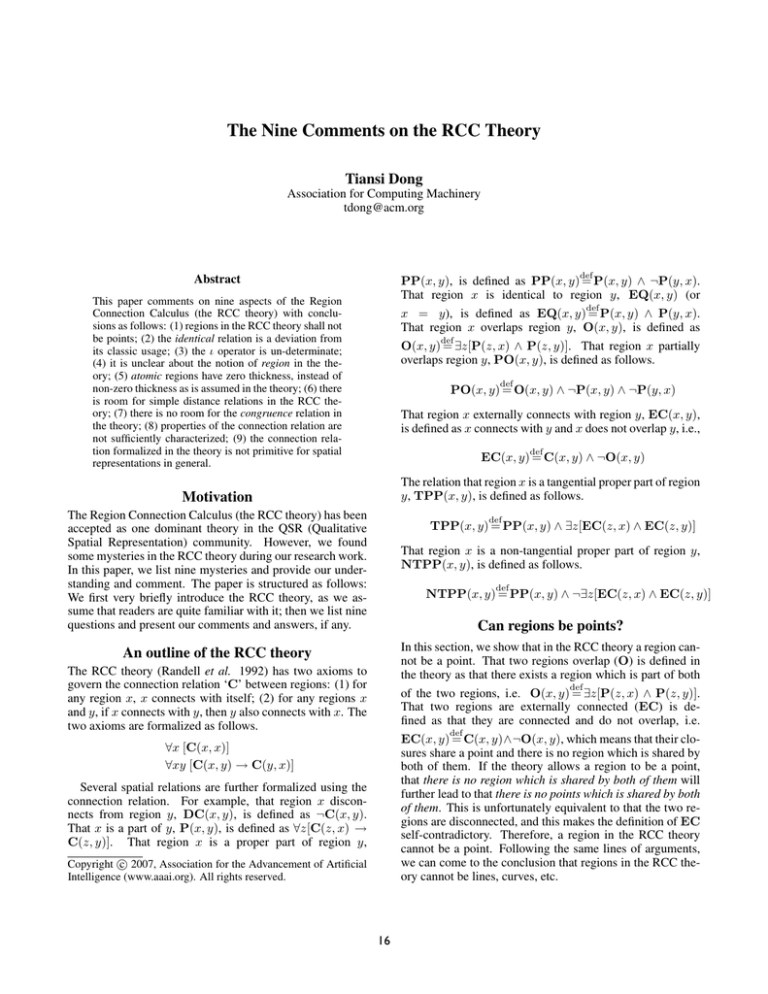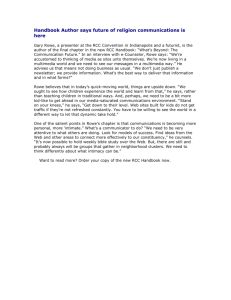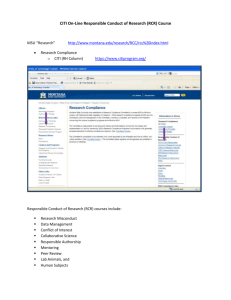
The Nine Comments on the RCC Theory
Tiansi Dong
Association for Computing Machinery
tdong@acm.org
def
PP(x, y), is defined as PP(x, y) = P(x, y) ∧ ¬P(y, x).
That region x is identical to region y, EQ(x, y) (or
Abstract
This paper comments on nine aspects of the Region
Connection Calculus (the RCC theory) with conclusions as follows: (1) regions in the RCC theory shall not
be points; (2) the identical relation is a deviation from
its classic usage; (3) the ι operator is un-determinate;
(4) it is unclear about the notion of region in the theory; (5) atomic regions have zero thickness, instead of
non-zero thickness as is assumed in the theory; (6) there
is room for simple distance relations in the RCC theory; (7) there is no room for the congruence relation in
the theory; (8) properties of the connection relation are
not sufficiently characterized; (9) the connection relation formalized in the theory is not primitive for spatial
representations in general.
def
x = y), is defined as EQ(x, y) = P(x, y) ∧ P(y, x).
That region x overlaps region y, O(x, y), is defined as
def
O(x, y) = ∃z[P(z, x) ∧ P(z, y)]. That region x partially
overlaps region y, PO(x, y), is defined as follows.
def
PO(x, y) = O(x, y) ∧ ¬P(x, y) ∧ ¬P(y, x)
That region x externally connects with region y, EC(x, y),
is defined as x connects with y and x does not overlap y, i.e.,
def
EC(x, y) = C(x, y) ∧ ¬O(x, y)
The relation that region x is a tangential proper part of region
y, TPP(x, y), is defined as follows.
Motivation
The Region Connection Calculus (the RCC theory) has been
accepted as one dominant theory in the QSR (Qualitative
Spatial Representation) community. However, we found
some mysteries in the RCC theory during our research work.
In this paper, we list nine mysteries and provide our understanding and comment. The paper is structured as follows:
We first very briefly introduce the RCC theory, as we assume that readers are quite familiar with it; then we list nine
questions and present our comments and answers, if any.
def
TPP(x, y) = PP(x, y) ∧ ∃z[EC(z, x) ∧ EC(z, y)]
That region x is a non-tangential proper part of region y,
NTPP(x, y), is defined as follows.
def
NTPP(x, y) = PP(x, y) ∧ ¬∃z[EC(z, x) ∧ EC(z, y)]
Can regions be points?
In this section, we show that in the RCC theory a region cannot be a point. That two regions overlap (O) is defined in
the theory as that there exists a region which is part of both
def
of the two regions, i.e. O(x, y) = ∃z[P(z, x) ∧ P(z, y)].
That two regions are externally connected (EC) is defined as that they are connected and do not overlap, i.e.
def
EC(x, y) = C(x, y)∧¬O(x, y), which means that their closures share a point and there is no region which is shared by
both of them. If the theory allows a region to be a point,
that there is no region which is shared by both of them will
further lead to that there is no points which is shared by both
of them. This is unfortunately equivalent to that the two regions are disconnected, and this makes the definition of EC
self-contradictory. Therefore, a region in the RCC theory
cannot be a point. Following the same lines of arguments,
we can come to the conclusion that regions in the RCC theory cannot be lines, curves, etc.
An outline of the RCC theory
The RCC theory (Randell et al. 1992) has two axioms to
govern the connection relation ‘C’ between regions: (1) for
any region x, x connects with itself; (2) for any regions x
and y, if x connects with y, then y also connects with x. The
two axioms are formalized as follows.
∀x [C(x, x)]
∀xy [C(x, y) → C(y, x)]
Several spatial relations are further formalized using the
connection relation. For example, that region x disconnects from region y, DC(x, y), is defined as ¬C(x, y).
That x is a part of y, P(x, y), is defined as ∀z[C(z, x) →
C(z, y)]. That region x is a proper part of region y,
c 2007, Association for the Advancement of Artificial
Copyright Intelligence (www.aaai.org). All rights reserved.
16
What does identical mean?
w
In the RCC theory, two regions x and y being identical (EQ
or =) is defined as that each is part of the other. This is
equivalent to that for any region z, z connects with x, if and
only if z connects with y, i.e.,∀z[C(z, x) ↔ C(z, y)]. As
C(x, y) is interpreted in the theory as closures of x and y
share a common point, two regions being identical means
their closures are perfectly coincided. That is, if region x2 +
y 2 ≤ 4 and region x2 + y 2 < 4 are two regions in the RCC
theory, they will be identical; if region x2 +y 2 ≤ 4, (x, y) =
(0, 0) and region x2 + y 2 ≤ 4 are two regions in the RCC
theory, they will be identical. This means that the identical
relation in the RCC theory is a deviation from its classic
usage, which can be stated as follows: x = y if, and only if,
x has every property which y has, and y has every property
which x has, (Tarski 1946, pp. 55). Therefore, in the classic
sense, neither region x2 + y 2 ≤ 4 and region x2 + y 2 < 4,
nor region x2 + y 2 ≤ 4, (x, y) = (0, 0) and region x2 +
y 2 ≤ 4 are identical. They only have the same closure. This
questions the unique denotation of the ι operator in the RCC
theory.
x
v
y
Figure 1: Region x is not identical with region y; region w
is identical with region v; either w or v can be a complement
of x or y. Then the complement of the complement of x is
not identical with x
if z is not part of x.
Which region does the ι operator denote?
def
compl(x) = ιy[∀z[[C(z, y) ↔ ¬NTPP(z, x)]
∧[O(z, y) ↔ ¬P(z, x)]]]
In the RCC theory the sum(x, y)1 function is defined as the
region w such that for any region z connecting with w, if
and only if z connects with x or y.
It holds that ∀x[compl(compl(x)) = x]. Let regions x, y,
w, and v be regions as illustrated in Figure 1. Region x
consists of two parts: an extended part and a curve; region
y is the extended part of x; the complement of region x
is identical with the complement of region y in the RCC
theory. And the complement of the complement of region
x is region y, not identical with region x. The theorem
∀x[compl(compl(x)) = x] will not be held. We would conclude that ιy[so-and-so] cannot be explained as the y soand-so in the RCC theory, and that if it is explained as any
y so-and-so with the condition that all these ys are identical inside the RCC theory, there must be some restrictions
on the notion of regions in the RCC theory, otherwise some
theorems in the theory will not be held.
def
sum(x, y) = ιw[∀z[C(z, w) ≡ [C(z, x) ∨ C(z, y)]]]
Let x and y be two non-closed2 regions in the RCC theory,
then the question is raised: which region can be the sum of
x and y, the joint region of x and y, the joint region of cl(x)3
and y, the joint region of x and cl(y), the joint region of cl(x)
and cl(y), or others? — there are indeed many regions which
are identical with the joint region of x and y in the RCC
theory. Classically, ιy[so-and-so] means ‘the so-and-so’ and
‘the so-and-so’ will be false if there are no so-and-so’s or
several so-and-so’s (Russell 1956, pp.92). Therefore, the ι
operator in the RCC theory is a deviation from the classic
usage. Our question is: Can ιy[so-and-so] mean that any
region y so-and-so and that all these regions are identical in
the RCC theory? The advantage of this explanation is that
the uniqueness of the ι descriptor is guaranteed inside the
RCC theory. Let us examine this explanation by considering
one property of the complement function defined in the RCC
theory. The compl(x) function is defined in (Randell et al.
1992, pp.168) as the region y such that for any region z two
conditions hold: (1) z connects with y if and only if z is not
non-tangential proper part of x; (2) z overlaps y if and only
What kinds of regions are regions?
The RCC theory stipulates what kinds of regions are regions
as follows: for every region x there is region y such that
y is non-tangential proper part of x, (Randell et al. 1992,
pp.169).
∀x∃y[NTPP(y, x)]
From this stipulation we know immediately that neither
points nor curves should be called as regions in the theory,
as we know that they do not have non-tangential part. The
question is: Does this stipulation exclude other kinds of regions? Is region x in Figure 1 a region in the theory? As region x has a non-tangential proper part, it should be a valid
region in the theory. In general, if there is a region r which
has non-tangential proper part, then for any region p including points and curves, the sum of r and p has non-tangential
proper part. Suppose the RCC theory were a country whose
1
In (Randell et al. 1992), the sum function is written incorrectly
as sum(x, y) =def ιy[∀z[C(z, y) ↔ [C(z, x) ∨ C(z, y)]]]. The
y in . . . ιy[∀z[C(z, y). . . should be replaced with a letter other than
x, y, z.
2
By a non-closed region, we mean a region which is not exactly
the same as its closure. For example, x2 + y 2 < 4 is a non-closed
region, as it is not exactly the same as its closure x2 + y 2 ≤ 4.
3
Following the notion appeared in (Randell et al. 1992, pp.
171), the closure of region x is written as ‘cl(x)’.
17
y
interpreted as that x is inside of y is defined as x is discrete
from y and x is part of y. Region x might be called a ghost
region of y, as it can be both inside of and discrete from y.
x
Does an atomic region have non-zero thickness?
(Randell et al. 1992, p. 173) discussed the notion of atomic
regions or atoms. Atomic regions are assumed as being ‘very
small’ and with non-zero thickness. That region x is an
atomic region is defined as follows.
Figure 2: Region x being inside of region y means that x is
discrete from y and that x is part of the convex hull of y
def
ATOM(x) = ∀y[P(y, x) → y = x]
citizens are regions, the above stipulation serves as a judger
who decides whether a person is a citizen of the country or
not. This judger would be rather ‘forgiving’ — for any person who is not a citizen of the country, he only needs to find
a citizen of the country and say to the judger, “we are together”. Then, the judger will say, “you both as a whole is a
citizen of the country”. This may introduce troubles into the
RCC theory. For example, suppose region x in Figure 1 is a
region in the theory, the theorem ∀x[compl(compl(x)) = x]
will not be held any more.
Similar problem also happens to the so-called convex-hull
of region: the convex-hull of region x, written as conv(x),
is characterized by a group of axioms, (Randell et al. 1992,
pp. 169), as follows.
We proof a theorem as follows.
Theorem 1 Given an atomic region x, it holds that for any
regions, z and w, if z connects with x, w connects with x,
then z connects with w.
∀z, w[C(z, x) → [C(w, x) → C(z, w)]]
Proof 1
(1)
(2)
(1) ∀x[P(x, conv(x))]
(2) ∀x[P(conv(conv(x)), conv(x))]
(3) ∀x∀y∀z[[P(x, conv(y)) ∧ P(y, conv(z))]
→ P(x, conv(z))]
(4) ∀x∀y[[P(x, conv(y)) ∧ P(y, conv(x))] → O(x, y)]
(5) ∀x∀y[[DR(x, conv(y)) ∧ DR(y, conv(x))]
→ DR(conv(x), conv(y))]
(3)
(4)
(5)
The above five axioms are also very ‘forgiving’ in stipulation, as for any region x, let conv(x) be x, the five axioms
are held as follows.
(1)
(2)
(3)
(4)
(5)
ATOM(x)
∀y[P(y, x) → y = x]
(1)
∀y[∀z[C(z, y) → C(z, x)]
→ ∀w[C(w, y) ↔ C(w, x)]]
(2), Let y be z
[∀z[C(z, z) → C(z, x)]
→ ∀w[C(w, z) ↔ C(w, x)]]
(3), ∀z[C(z, z)]
∀z[C(z, x) → ∀w[C(w, z) ↔ C(w, x)]]
(4)
∀z[C(z, x) → ∀w[C(w, x) → C(w, z)]]
This theorem shows that for any regions w and z, if they
connect with an atomic region, they will connect with each
other. Formula (5) ∀z[C(z, x) → ∀w[C(w, x) → C(w, z)]]
is equivalent with ∀z[C(z, x) → P(x, z)], which means that
for any region z, if an atomic region connects with z, then
it is part of z. All these imply that an atomic region has
zero thickness, instead of non-zero thickness. Including regions with zero thickness into the theory would cause inconsistency. And including atomic regions into the theory
indeed introduced inconsistency, as mentioned in (Randell
et al. 1992, pp. 173-174). What we would mention here is
that in some work the notion of point is characterized just
the same as the notion of the atomic region. For example in
(Smith 1996, pp. 289), a point x, written as Pt(x) is defined
as ∀y(yPx → y = x), which means for any y, if y is part of
x, then y is identical to x. From this point, we will be easier
to understand why introducing atomic regions into the theory would cause inconsistency — atomic regions are in fact
points, and regions in the theory cannot be points.
∀x[P(x, x)]
∀x[P(x, x)]
∀x∀y∀z[[P(x, y) ∧ P(y, z)] → P(x, z)]
∀x∀y[[P(x, y) ∧ P(y, x)] → O(x, y)]
∀x∀y[[DR(x, y) ∧ DR(y, x)] → DR(x, y)]
This may introduce troubles into the RCC theory, when
we consider the inside relation: region x being inside of region y is defined as that x is discrete from y and x is part
of the convex full of y, (Randell et al. 1992, p. 169), as
illustrated in Figure 2.
def
INSIDE(x, y) = DR(x, y) ∧ P(x, conv(y))
When conv(x) is taken as x, the definition of INSIDE(x, y)
will turn out to be DR(x, y) ∧ P(x, y), which would be
18
x
x
x’
y
z
z’
Figure 3: Region x and region x are congruent, as x can be
perfectly placed on x by moving and rotation
Figure 4: Region x connects region y, for any region z, there
is region z which is congruent with z and which connects
with x and y
Is there room for distance in the RCC theory?
either G(x, y) holds, if and only if x and y are congruent, or
G(x, y) holds, if and only if x and y are not congruent.
We are not so optimistic about the existence of such a
formula, for the reason that the RCC theory talks about
‘locations’ of regions in terms of the connection relation,
while ‘congruence’ is about the shape and the size of regions which is independent on ‘locations’. Two regions is
(or is not) congruent, while they can be located anywhere,
e.g. they can be connected, externally connected, partially
overlapped, or disconnected, etc. This hypothesize can be
proved by structural induction through the construction of
formula. For the simplest case, we first consider C(z1 , z2 ),
C(x, z), C(z, y), and C(x, y). Their values are independent from whether x and y are congruent. Suppose D(x, y),
F(x, y) are any two formula whose values are independent
from whether x and y are congruent. We need to show that
values of ¬D(x, y), D(x, y) ∨ F(x, y), D(x, y) ∧ F(x, y),
D(x, y) → F(x, y), ∀zD(x, y), and ∃zD(x, y) are all independent from whether x and y are congruent. Let v1 and
v2 be the values of D(x, y) and F(x, y), respectively. v1
and v2 can be t (true) or f (false). Then, values of ¬D(x, y)
D(x, y) ∨ F(x, y), D(x, y) ∧ F(x, y), D(x, y) → F(x, y)
are all determined by v1 and v2 . ∀zD(x, y) is equivalent to Dz1 (x, y) ∧ Dz2 (x, y) ∧ . . . ∧ Dzn (x, y), where zi
(1 < i < n) is in the domain of z; ∃zD(x, y) is equivalent to Dz1 (x, y) ∨ Dz2 (x, y) ∨ . . . ∨ Dzn (x, y), where zi
(1 < i < n) is in the domain of z, therefore their values are
not related with whether x and y are congruent or not.
In this section, we discuss whether there is room for distance
relations in the RCC theory. The answer seems positive, as
this is at least evidenced in (Cohn and Bennett 1997, 7): An
alternative interpretation of C might be given informally by
saying the distance between the two regions is zero. That
is, the RCC theory can also be viewed as a calculus whose
primitive relation is the distance between two regions is zero.
Further, let us think about the distance relation as follows:
‘distance-less-than-or-equal-to-one-foot(x, y)’, read as “region x is less than or equal to one foot away from region y”.
This distance relation is reflexive and symmetrical: x is less
than or equal to one foot away from itself (reflexive); if x
is less than or equal to one foot away from y, then y is less
than or equal to one foot away from x (symmetrical). This is
also a valid interpretation for the C relation. Generally, let p
be a non-negative real number, ‘distance-less-than-or-equalto-p-meter(x,y)’ is a reflexive, and symmetrical relation and
therefore can be an interpretation of C. When p is zero, the
theory is a connection calculus; when p is greater than zero,
the theory would be a simple distance calculus. The distance
between x and y being more than p meter can be represented
by ¬C(x, y). We conclude that although the RCC theory is
named as a calculus with the connection relation, it can also
be used as a calculus for simple distance relations.
Can the congruence relation between regions
be delineated in the RCC theory?
The congruence relation (the geometric equivalence) is one
of the main topics in geometry, (Flegg 1974). Two objects
being congruent means that one can be perfectly placed on
the other, as illustrated in Figure 3. In the RCC theory the
congruence relation between regions should be interpreted
as the closure of one region can be perfectly placed on the
closure of the other. Our question is: can the congruence
relation between regions be represented in the RCC theory?
This is equivalent to ask: is there such a formula G(x, y)
that G(x, y) holds if and only if regions x and y are congruent, where G(x, y) is constructed by the relation C and
notions in the first order logic. If G(x, y) is such a formula,
then ¬G(x, y) is such that when y is congruent with x, it
does not hold, and that when y is not congruent with x, it
holds. This is also a valid formula to determine whether two
regions are congruent, but in a non-conventional way – just
like, in some countries people give positive attitude by shaking the head, and give negative attitude by nodding the head.
Therefore, the property of G(x, y) can be stated as follows:
Are properties of the connection relation
sufficiently characterized by the axioms?
The RCC theory uses the connection relation C as the primitive relation. Two axioms characterize properties of the connection relation as reflexive and symmetrical: ∀x[C(x, x)]
and ∀xy[C(x, y) → C(y, x)]. We claim that the two properties do not sufficiently characterize properties of the connection relation. If it were, the two axioms should be able
to deduce any property of the connection relation. Let us
think about one property as follows: if two regions are connected, then for any region p, we can find a place for it,
so that p can connect with the two regions. This property
even holds, when p is a point — if p is located at any of the
shared part of the closures of the two connected regions, p
will connect with both of them. This property can also be
stated as follows: for any regions x, y, and z, if x connects
with y, then there is region z such that z is congruent with
19
z, and that z connects with x and y, as illustrated in Figure
4. As the congruence relation can not be delineated in the
RCC theory, this property of the connection relation cannot
be represented either. So, we conclude that the RCC theory
does not delineate all primitive properties of the connection
relation. However, this will not be a problem, if those delineated properties of the connection relation can construct all
spatial properties that the theory wishes to represent.
of the distance being less than two Cubits. If the distance between x and y being less than or equal to one Cubit means
that there is a region which is congruent with Cubit such
that this region connects with x and y, the distance between
x and y being less than or equal to two Cubits shall mean
that there are two regions which are congruent with Cubit
and such that when they connect with one another, they shall
connect with x and y. However, as we have shown that there
is no room for the congruence relation in the RCC theory,
there is also no room for relations which are based on the
congruence relation, such as distance relations.
Is C primitive for spatial relations?
The relation C is primitive in the RCC theory, as all the
spatial relations appear in the theory are defined through it.
However, the fact that the axioms in the RCC theory can
neither characterize nor deduce one property of the connection relation leads to the question: are there spatial relations
which can be interpreted through the connection relation but
cannot be represented in the RCC theory? If yes, we will
have to conclude that C is not primitive for spatial relations,
even the connection relation is. In the above section, we
have shown that the congruence relation cannot be developed through C. In the following part, we will show that
the C relation in the RCC theory cannot describe more than
two distance relations in one interpretation. By doing so we
argue that the C relation in the RCC theory is not a primitive relation for spatial relations, in the sense that it cannot
develop sufficient distance relations.
The definition of distance in general has been discussed
in mathematical philosophy and general topology, (Russell
1903), (Kelley 1955). However, such mathematical or philosophical perspectives to view the notion of distance relation
do not meet the motivation for grounding the RCC theory
which took the naive point of view: From the standpoint
of our naive understanding of the world, this topological
structure is arguably too rich for our purposes, . . . Given the
choice between two possible theories used for formal representing space, the ease by which a person can understand
and use the theory must be taken into account. The basic
part of the original theory . . . required the user to be familiar with general topology . . . . We thought this restriction
could be eased . . . (Randell et al. 1992, pp. 166). We
therefore will take a naive point of view to analyze one understanding of distance relations, and show why such understanding is beyond the descriptive power of the C relation.
Ancient Egyptians used the notion of Royal Egyptian Cubit to describe distances. The length of a Cubit is defined
as the length of the forearm from the bent elbow to the tip
of the extended middle finger plus the width of the palm of
the hand of the Pharaoh or King ruling at that time. The
distance between two objects being no more than one Cubit
can be understood as there is a cubit which can connect with
the two objects. If C is interpreted as one kind of distance
relation, e.g. C(x, y) is interpreted as the distance between
x and y is no more than one Cubit, there will be two basic
distance relations distinguished: the distance between two
regions is less than or equal to one Cubit, C, and the distance between two regions is more than one Cubit, ¬C. The
question is raised: Can distance relations, such as less than
two/ three/four Cubits be described in the RCC theory? To
answer this question, we shall first make clear the meaning
References
A. G. Cohn and B. Bennett. Qualitative spatial representation and reasoning with the region connection calculus.
GeoInformatica, 1:1–44, 1997.
H. Graham Flegg. From Geometry to Topology. The English Universities Press Ltd, 1974.
J. K. Kelley. General Topology. Springer, New York, 1955.
D.A. Randell, Z. Cui, and A.G. Cohn. A spatial logic based
on regions and connection. In B. Nebel, W. Swartout, and
C. Rich, editors, Proceeding 3rd International Conference
on Knowledge Representation and Reasoning, pages 165–
176, San Mateo, 1992. Morgan Kaufmann.
B. Russell. The Principles of Mathematics. W.W.Norton&
Company, Inc., 1903. citation, if any, according to the Norton paperback edition reissued in 1996.
B. Russell. Logic and Knowledge. Routledge, an imprint
of Taylor & Francis Books Ltd, 1956.
B. Smith. Mereotopology: A Theory of Parts and Boundaries. Data and Knowledge Engineering, 20:287–303,
1996.
A. Tarski. Introduction to Logic and to the Methodology of
Deductive Sciences. Oxford University Press, New York,
1946. citation based on the Dover edition, first published
in 1995.
20






